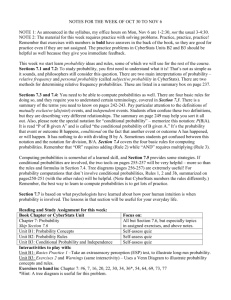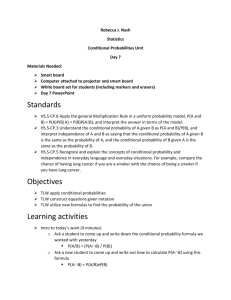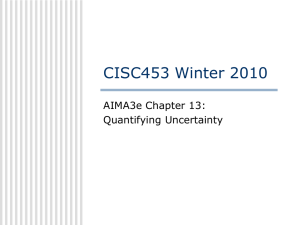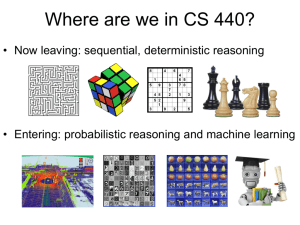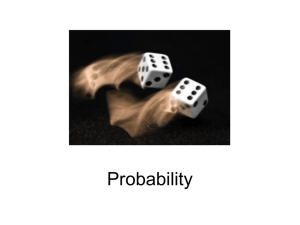1-01 Probability Theory 1 01-0: Notation • A Random Variable (or
advertisement
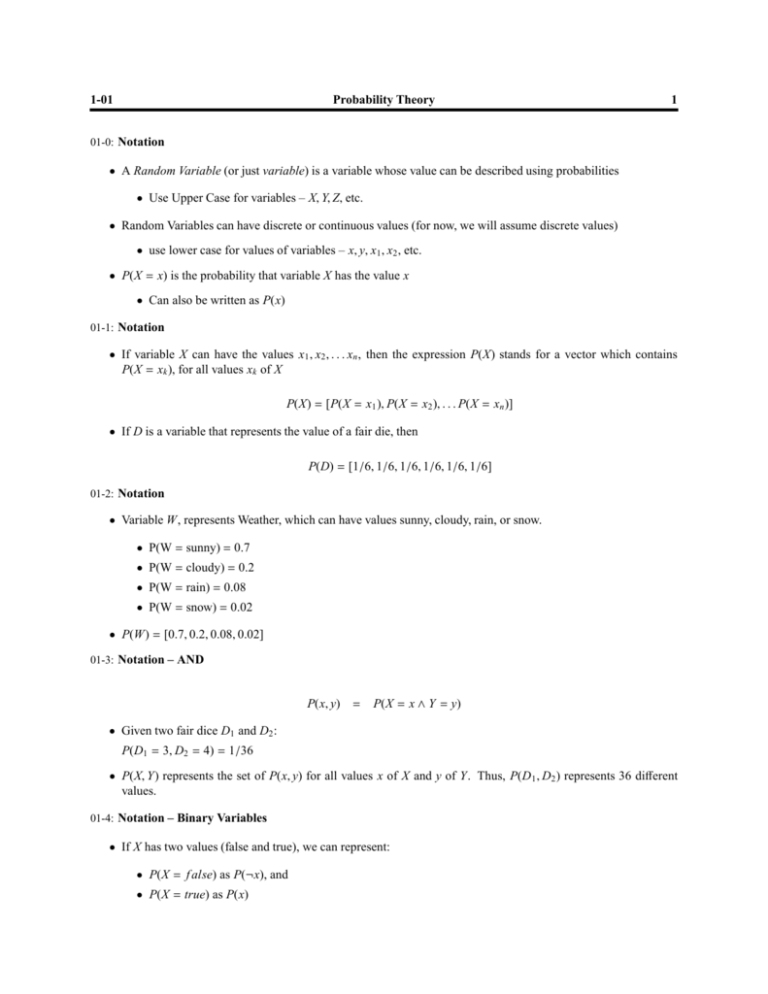
1-01 Probability Theory 1 01-0: Notation • A Random Variable (or just variable) is a variable whose value can be described using probabilities • Use Upper Case for variables – X, Y, Z, etc. • Random Variables can have discrete or continuous values (for now, we will assume discrete values) • use lower case for values of variables – x, y, x1 , x2 , etc. • P(X = x) is the probability that variable X has the value x • Can also be written as P(x) 01-1: Notation • If variable X can have the values x1 , x2 , . . . xn , then the expression P(X) stands for a vector which contains P(X = xk ), for all values xk of X P(X) = [P(X = x1 ), P(X = x2 ), . . . P(X = xn )] • If D is a variable that represents the value of a fair die, then P(D) = [1/6, 1/6, 1/6, 1/6, 1/6, 1/6] 01-2: Notation • Variable W, represents Weather, which can have values sunny, cloudy, rain, or snow. • P(W = sunny) = 0.7 • P(W = cloudy) = 0.2 • P(W = rain) = 0.08 • P(W = snow) = 0.02 • P(W) = [0.7, 0.2, 0.08, 0.02] 01-3: Notation – AND P(x, y) = P(X = x ∧ Y = y) • Given two fair dice D1 and D2 : P(D1 = 3, D2 = 4) = 1/36 • P(X, Y) represents the set of P(x, y) for all values x of X and y of Y. Thus, P(D 1 , D2 ) represents 36 different values. 01-4: Notation – Binary Variables • If X has two values (false and true), we can represent: • P(X = f alse) as P(¬x), and • P(X = true) as P(x) 1-01 Probability Theory 2 01-5: Conditional Probability • P(x|y) = Probability that X = x given that all we know is Y = y • P(cavity|toothache) = 0.8 • P(Cavity|T oothache) represents 4 values: " P(¬cavity|¬toothache) P(cavity|¬toothache) P(¬cavity|toothache) P(cavity|toothache) 01-6: Conditional Probability • We can define conditional probabilities in terms of unconditional probabilities. P(a|b) = P(a, b) P(b) Whenever P(b) > 0 • P(a, b) = P(a|b)P(b) = P(b|a)P(a) • P(A, B) = P(A|B)P(B) means P(a, b) = P(a|b)P(b) for all values a, b 01-7: Axioms of Probability • 0 ≤ P(a) ≤ 1 • P(true) = 1, P( f alse) = 0 • P(a ∨ b) = P(a) + P(b) − P(a ∧ b) Everything follows from these three axioms For instance, prove P(x) = 1 − P(¬x) 01-8: Axioms of Probability • 0 ≤ P(a) ≤ 1 • P(true) = 1, P( f alse) = 0 • P(a ∨ b) = P(a) + P(b) − P(a ∧ b) P(x ∨ ¬x) = 1 = P(x) + P(¬x) − P(x ∧ ¬x) P(x) + P(¬x) − 0 1 − P(¬x) = P(x) P(x) = 1 − P(¬x) 01-9: Joint Probability # 1-01 Probability Theory • Probability for all possible values of all possible variables cavity toothache 0.04 cavity ¬toothache 0.06 ¬cavity toothache 0.01 ¬cavity ¬toothache 0.89 • From the joint, we can calculate anything • P(cavity) = 0.04 + 0.06 = 0.01 • P(cavity ∨ toothache) = 0.04 + 0.06 + 0.01 = 0.11 • P(cavity|toothache) = P(c, t)/P(t) = 0.04 / (0.04 + 0.01) = 0.80 01-10: Joint Probability • Joint can tell us everything • Calculate the joint, read off what you want to know • This will not work! • x different variables, each of which has v values • Size of joint = v x • 50 variables, each has 7 values, 1.8 ∗ 1042 table entires 01-11: Conditional Probability • Working with the joint is impractical • Work with conditional probabilities instead • Manipulate conditional probabilities based on definition: P(A|B) = P(A, B) P(B) (when P(B) is always > 0) 01-12: Bayes Rule P(B|A) = = P(A ∧ B) P(A) P(A|B)P(B) P(A) Generalize Bayes Rule, with additional evidence E: P(B|A ∧ E) = = 01-13: Using Bayes Rule P(A ∧ B|E) P(A|E) P(A|B ∧ E)P(B|E) P(A|E) 3 1-01 Probability Theory • Rare disease, strikes one in every 10,000 • Test for the disease that is 95% accurate: • P(t|d) = 0.95 • P(¬t|¬d) = 0.95 • Someone tests positive for the disease, what is the probability that they have it? • P(d|t) = ? 01-14: Using Bayes Rule • P(d) = 0.0001 • P(t|d) = 0.95 (and hence P(¬t|d) = 0.05) • P(¬t|¬d) = 0.95 (and hence P(t|¬d) = 0.05) P(d|t) = P(t|d)P(d)/P(t) = 0.95 ∗ 0.0001/(P(t|d)P(d) + P(t|¬d)P(¬d)) = 0.95 ∗ 0.0001/(0.95 ∗ 0.0001 + 0.05 ∗ 0.9999) = 0.0019 01-15: Conditional Independence • Variable A is conditionally independent of variable B, if P(A|B) = P(A) • Notation: (A y B) • D – roll of a fair die (d1 . . . d6 ) • C – value of a coin flip (h or t) • P(D|C) = P(D) P(C|D) = P(C) • (A y B) ⇔ (B y A) • P(A|B) = P(A) ⇔ P(B|A) = P(B) 01-16: Conditional Independence • If A and B are independent, then P(a, b) = P(a)P(b) • (Also used as a definition of conditional independence – two definitions are equivalent) • P(a, b) = P(a|b)P(b) = P(a)P(b) 01-17: Conditional Independence 4 1-01 Probability Theory • At an elementary school, reading scores and shoe sizes are correlated. Why? Age Shoe Size Reading Ability • P(R|S ) , P(R) • P(R|S, A) = P(R|A) • Notation: (R y S |A) 01-18: Monte Hall Problem From the game show “Let’s make a Deal” • Pick one of three doors. Fabulous prize behind one door, goats behind other 2 doors • Monty opens one of the doors you did not pick, shows a goat • Monty then offers you the chance to switch doors, to the other unopened door • Should you switch? 01-19: Monte Hall Problem Problem Clarification: • Prize location selected randomly • Monty always opens a door, allows contestants to switch • When Monty has a choice about which door to open, he chooses randomly. Variables Prize: P = pA , pB , pC Choose: C = cA , cB , cC Monty: M = mA , mB , mC 01-20: Monte Hall Problem Without loss of generality, assume: • Choose door A • Monty opens door B P(pA |cA ) P(pA |cA , mB ) = P(mB|cA , pA ) P(m B |cA ) 01-21: Monte Hall Problem P(pA |cA ) P(pA |cA , mB ) = P(mB|cA , pA ) P(m B |cA ) = 1/3 • P(mB|cA , pA ) = 1/2 • P(pA |cA ) = 1/3 5 1-01 Probability Theory • P(mB|cA ) = P(mb |cA , pA )P(pA )+ P(mb |cA , pB)P(pB)+ P(mb |cA , pC )P(pC ) = 1/2 • P(pA ) = P(pB) = P(pC ) = 1/3 • P(mb |cA , pA ) = 1/2 • P(mb |cA , pB ) = 0 Won’t open prize door • P(mb |cA , pC ) = 1 Monty has no choice P(p |c ) 01-22: Monte Hall Problem P(pC |cA , mB ) = P(mB|cA , pC ) P(mC |cA ) B A = 2/3 • P(mB|cA , pC ) = 1 • P(pC |cA ) = 1/3 • P(mB|cA ) = P(mb |cA , pA )P(pA )+ P(mb |cA , pB)P(pB)+ P(mb |cA , pC )P(pC ) = 1/2 • P(pA ) = P(pB) = P(pC ) = 1/3 • P(mb |cA , pA ) = 1/2 • P(mb |cA , pB ) = 0 Won’t open prize door • P(mb |cA , pC ) = 1 Monty has no choice 01-23: Rare Disease Redux • Rare disease, strikes one in every 10,000 • Two tests, one 95% accurate, other 90% accurate: • P(t1|d) = 0.95, P(¬t1|¬d) = 0.95 • P(t2|d) = 0.90, P(¬t2|¬d) = 0.90 • Tests use independent mechanisms to detect disease, and are conditionally independent, given disease state: • P(t1|d, t2) = P(t1|d) • Both test are positive, what is the probability of disease? • P(d|t1, t2) = ? 01-24: Rare Disease Redux P(d|t1, t2) P(t1|t2) P(d|t2) P(d|t2) = P(t1|d, t2) P(t1|t2) P(d|t2) = P(t1|d) P(t1|t2) = 0.0168 = P(t1|t2, d)P(d|t2) + P(t1|t2, ¬d)P(¬d|t2) = P(t1|d)P(d|t2) + P(t1|¬d)P(¬d|t2) = 0.05081 P(d) = P(t2|d) P(t2) = 0.0009 6 1-01 Probability Theory 7 P(t2) = P(t2|d)P(d) + P(t2|¬d)P(¬d) = .10008 01-25: Probabilistic Reasoning • Given: • Set of conditional probabilities (P(t1|d), etc) • Set of prior probabilities (P(d)) • Conditional independence information (P(t1|d, t2) = P(t1|d)) • We can calculate any quantity that we like 01-26: Probabilistic Reasoning • Given: • Set of conditional probabilities (P(t1|d), etc) • Set of prior probabilities (P(d)) • Conditional independence information (P(t1|d, t2) = P(t1|d)) • We can calculate any quantity that we like • Problems: • Hard to know exactly what data we need • Even given sufficient data, calculations can be complex – especially dealing with conditional independence 01-27: Bayesian Networks Bayesian Networks are: • Clever encoding of conditional independence information • Mechanical, “turn the crank” method for calculation • Can be done by a computer Nothing “magic” about Bayesian Networks 01-28: Directed Acyclic Graphs • We will encode conditional independence information using Directed Acyclic Graphs (or DAGs) • While we will use causal language to give intuitive justification, these DAGs are not necessarily causal (more on this later) • Three basic “junctions” 1-01 Probability Theory 01-29: Head-to-Tail A B C • “Causal Chain” • Rain → Wet Pavement → Slippery Pavement • (A 6y C) • (A y C|B) 01-30: Tail-to-Tail B A C • “Common Cause” • Reading Ability ← Age → Shoe Size • (A 6y C) • (A y C|B) 01-31: Head-to-Head A C B • “Common Effect” • Rain → Wet Grass ← Sprinkler • (A y C) • (A 6y C|B) 8 1-01 Probability Theory 01-32: Head-to-Head Rain Sprinkler Wet Grass Slugs • Also need to worry about descendants of head-head junctions. • (Rain y Sprinkler) • (Rain 6y Sprinkler | Slugs) 01-33: Markovian Parents • V is an ordered set of variables X1 , X2 , . . . Xn . • P(V) is a joint probability distribution over V • Define the set of Markovian Parents of variable X j , PA j as: • Minimal set of predecessors of X j such that • P(X j |X1 , . . . X j−1 ) = P(X j |PA j ) • The Markovian Parents of a variable X j are often (but not always) the direct causes of X j 01-34: Markovian Parents & Joint • For any set of variables X1 , . . . Xn , we can calculate any row of the joint: • P(x1 , ...xn ) = P(x1 )P(x2 |x1 )P(x3 |x1 , x2 ) . . . P(xn |x1 , x2 , . . . xn−1 ) • Using Markovian parents • P(x1 , ...xn ) = P(x1 )P(x2 |PA2 )P(x3 |PA3 ) . . . P(xn |PAn ) 01-35: Markovian Parents & DAGs • We can create a DAG which represents conditional independence information using Markovian parents. • Each variable is a node in the graph • For each variable X j , add a directed link from all elements in PA j to X j • Example: Burglary, Earthquake, Alarm, John Calls, Mary Calls, News Report 9 1-01 Probability Theory 10 01-36: DAG Example Burglary Earthquake News Report Alarm John Calls Mary Calls 01-37: DAGs & Cond. Independence • Given a DAG of Markovian Parents, we know that every variable X i is independent of its ancestors, given its parents • We also know quite a bit more 01-38: d-separation To determine if a variable X is conditionally independent of Y given a set of variables Z: • Examine all paths between X and Y in the graph • Each node along a path can be “open” or “blocked” • A node at a head-to-tail or tail-to-tail junction is open if the node is not in Z, and closed otherwise. • A node at a head-to-head junction is open if the node or any of its descendants is not in Z, and closed otherwise. Examples (on board)


